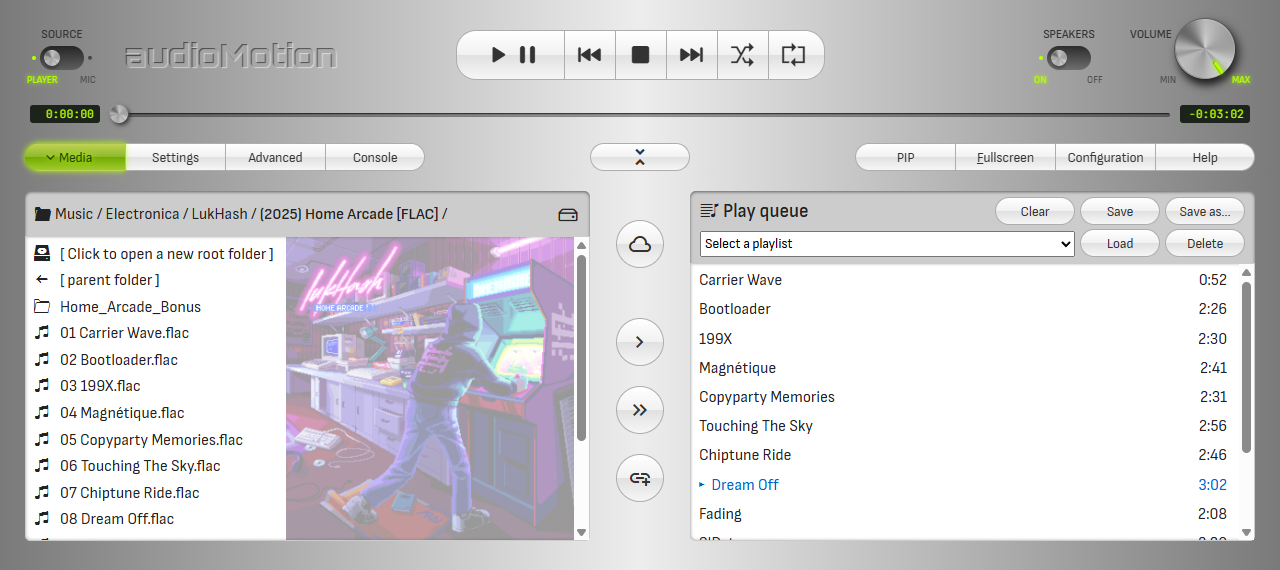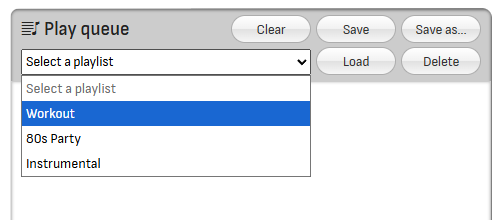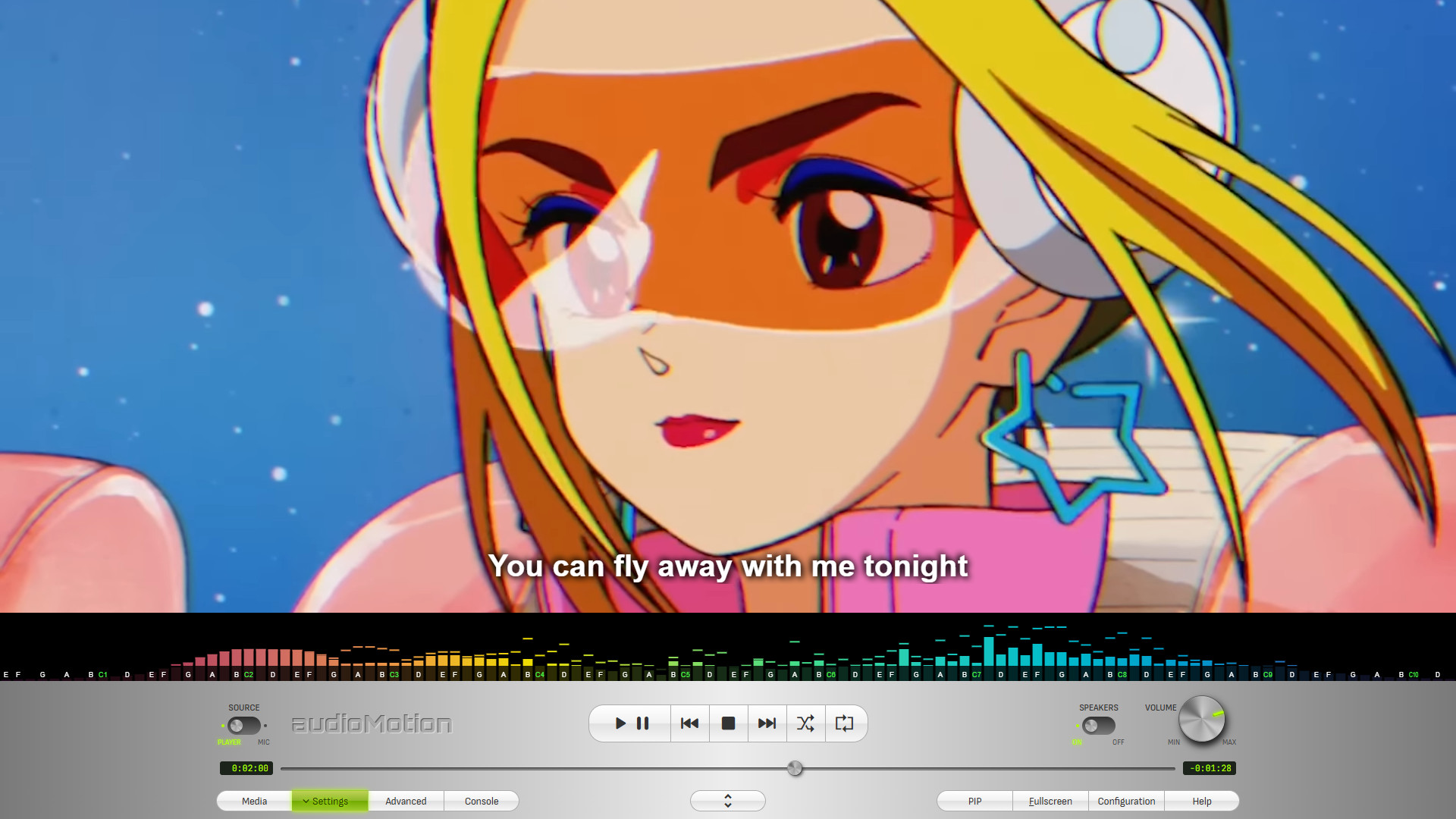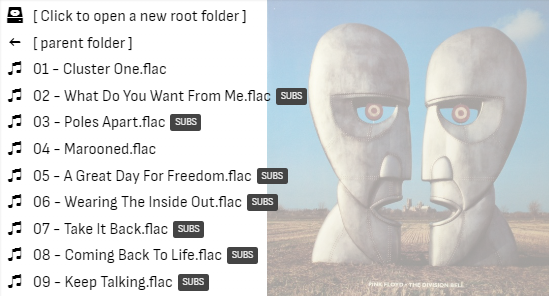audioMotion.js
Media Panel
Click Media in the panel selection buttons to open the Media Panel.

The Media Panel is comprised of the File Explorer on the left, the action buttons at the center, and the Play Queue on the right.

File Explorer
The File Explorer allows you to navigate through your media folders and files.
!> Access to files in your device is provided by the File System Access API,
which is currently implemented only on Chromium-based browsers (e.g., Chrome, Opera and Edge).
On Brave browser it needs to be enabled in chrome://flags/#file-system-access-api (copy and paste it in the address bar).
Double-click a file to quickly add it to the play queue. It will also start playing if the player is currently stopped.
Hold Ctrl and click to select multiple files, or Shift + click to select a range of contiguous files.
You can then drag and drop the selected files into the play queue, or use the action buttons:
| button | action |
|---|---|
 |
Switch between browsing folders on your local device or hosted on the app server |
 |
Add currently selected files in the file explorer to the play queue |
 |
Add all files in the current folder to the play queue |
 |
Add a remote audio file or stream from an URL |
 |
Open and play a single media file from your device (Only displayed if the browser/device does NOT support the File System Access API) |
?> The first image found in the current folder will be shown in the background of the file explorer, with precedence given to filenames containing the words cover, folder or front (in this order).
Playlist files
The File Explorer can load playlist files in M3U format (.m3u or .m3u8 extensions), which are basically text files with one filename per line.
The Extended M3U format’s #EXTINF and #EXTALB directives are also supported,
and allow adding artist names, album and song titles for media files that don’t have embedded metadada.
Playlist entries may include folder names, including .. to access upper-level folders, but all paths must be relative to the location of the .m3u file itself,
i.e., paths must not start with a slash or drive letter.
Playlists can also include remote media files and streams, using https:// protocol.
Example of an .m3u file:
#EXTM3U
#
# See https://en.wikipedia.org/wiki/M3U#Extended_M3U for format reference.
#
# Note: EXTALB is applied to all songs that come after it, no need to repeat it.
#
#EXTALB:Animals (1977)
#EXTINF:84,Pink Floyd - Pigs on the Wing. Part 1
track01.mp3
#EXTINF:1025,Pink Floyd - Dogs
track02.mp3
#EXTINF:686,Pink Floyd - Pigs (Three Different Ones)
track03.mp3
#EXTINF:619,Pink Floyd - Sheep
track04.mp3
#EXTINF:85,Pink Floyd - Pigs on the Wing. Part 2
track05.mp3
Play queue and saved playlists
Double-click a queued song to play it.
Click a queue entry to select it (use Ctrl/Shift to select multiple files). Drag-and-drop selected entries to reorder them inside the queue.
Press Delete (Backspace on Mac) to remove selected entries from the queue.
Click the Clear button to clear the play queue.
The play queue is automatically restored the next time you open audioMotion. You can disable this feature in Configuration > General settings.

You can save the play queue to internal playlists for quick access.
Saved playlists appear in the playlist selection box (shown right).
Create and manage your playlists using the following buttons:
| Button | Action |
|---|---|
| Save as… | Saves the current queue contents to a new playlist |
| Save | Update the selected playlist with the current queue contents |
| Load | Load the selected playlist, adding its contents to the end of the current queue |
| Delete | Permanently delete the selected playlist |
!> Saved playlists are stored in the browser’s internal storage and will only be accessible in the same browser they were saved.
Subtitles
audioMotion can display subtitles in WebVTT format (.vtt), for video and audio files.

Subtitle files must be in the same folder and have the same base name of its corresponding media file, with a lowercase .vtt extension.
Media files with detected subtitles will show a [SUBS] badge next to their names in the File Explorer, as shown below:

Configure the subtitles appearance in Configuration > Subtitles & Video. Toggle the display of subtitles with the SUBTITLES switch.
?> Download synced lyrics for your songs with LRCGET and use Subtitle Edit to convert them (and other popular subtitle formats) to .vtt.
Supported file formats
- Audio: flac, m4a, mp3, ogg and wav;
- Video (for playback and Background): mkv, mpg, webm, mp4, avi and mov;
- Images (for folder covers and Background): jpg, jpeg, webp, avif, png, gif and bmp;
- Playlists (see Playlist files): m3u and m3u8;
- Subtitles (see Subtitles): vtt.
Actual codec support may vary, depending on browser and operating system.